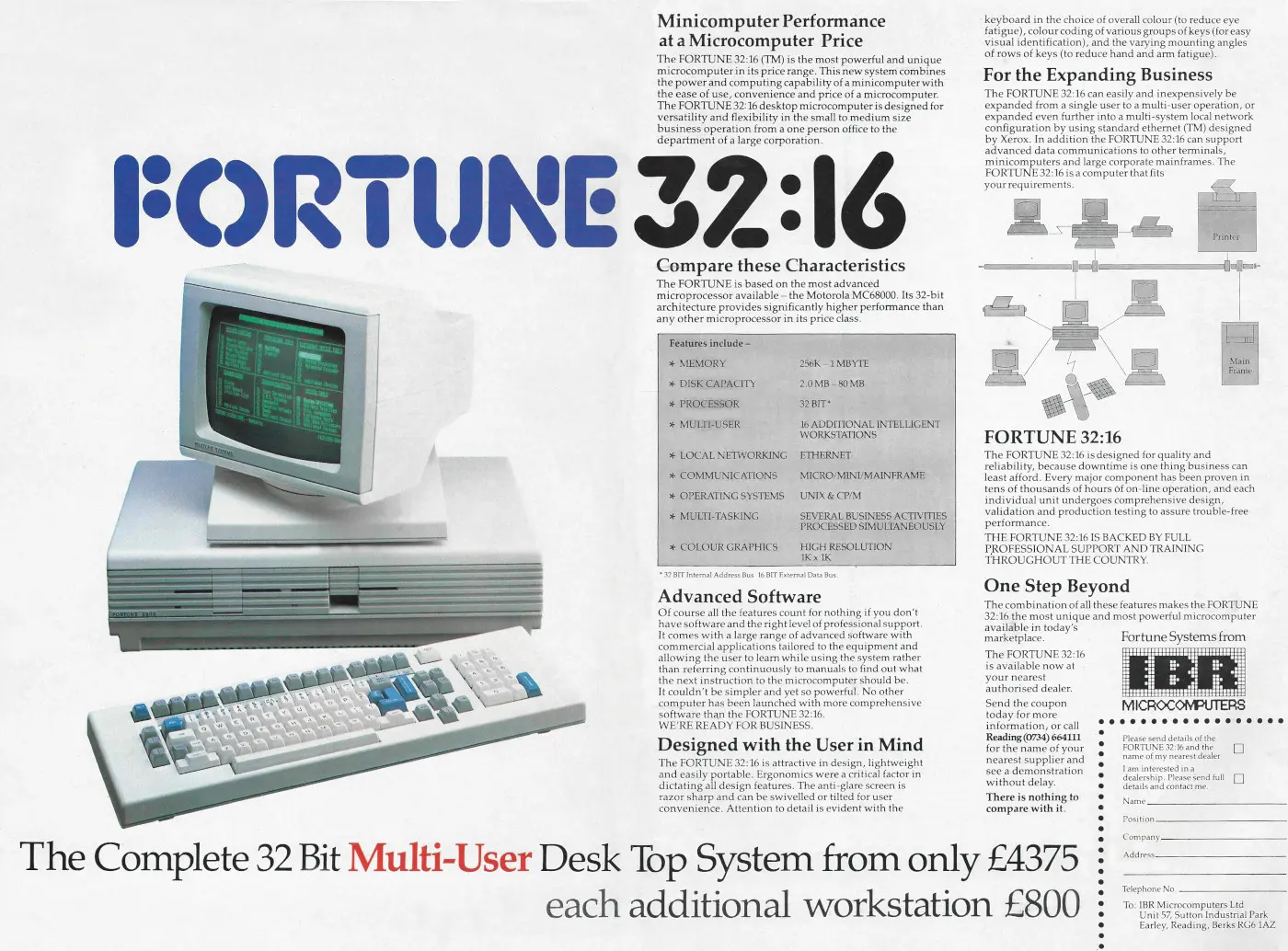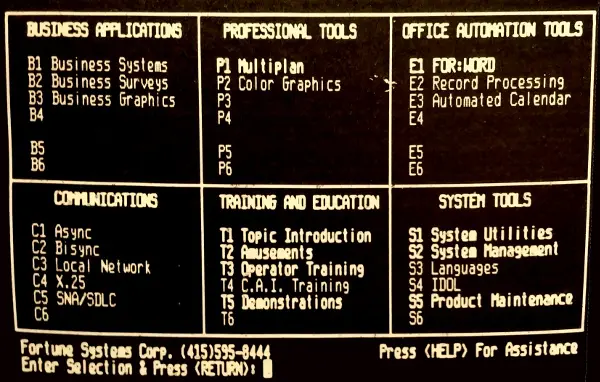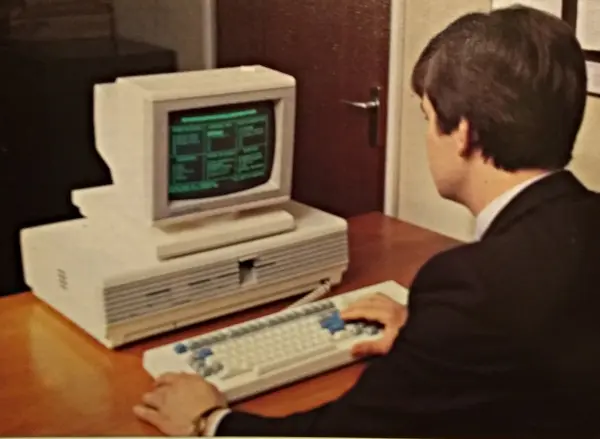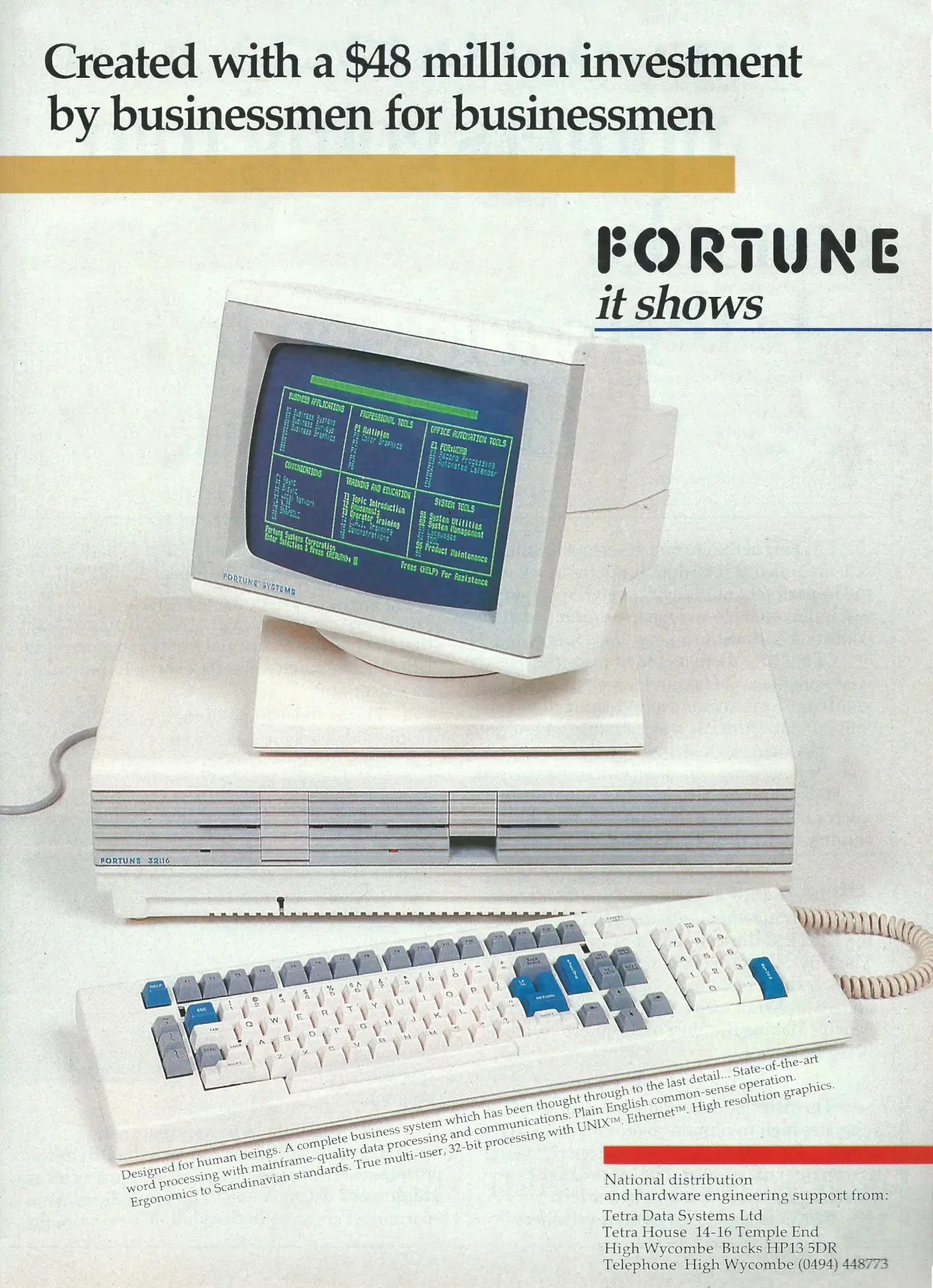Fortune Advert - December 1982
From Personal Computer World

Fortune 32:16 - Minicomputer Performance at Microcomputer Price

Fortune's £1 million user interface, © Practical Computing January 1983Based in San Carlos, California, Fortune was founded as a start-up in October 1981 with $8.5 million dollars which, at about £32 million in 2025 terms, was possibly the largest seed investment ever made to a microcomputer company at the time[1].
By early 1983 it was claiming a total of $48 million investment, which is around £140 million in 2025 terms[2].
It quickly set to work spending its seed money, spending an alleged £1 million on adapting Unix and writing a user-friendly text-based shell around the unforgiving command-line interface that Unix provided.
The end result, according to Practical Computing's January 1983 review did at least lead to a system that was "much more user-friendly than the average computer"[3].
Personal Computer World also reveiwed the machine, with Peter Rodwell commenting that:
"Big computer users are used to thinking in terms of megabucks so while the Fortune is outrageously expensive in comparison to other single-user micros, it's bargain-basement stuff to these big users and should therefore appeal strongly. This is quite definitely not the machine for the corner newsagent - it's not marketed as such, it's not priced as such and it wouldn't be particularly appropriate in that environment. Personally, I developed a sort of love-hate relationship with the machine: sometimes I loved it, sometimes I hated it. I loved its user-friendliness and ease of use at the global level: it's very well thought out and one of the best machines I've ever seen from this point of view. If I had to pass a short and snappy verdict on the Fortune, then I'd say: nice mini, shame it's not a micro[4]".
The system was considered quite ahead of its time, with its 32-bit Motorola 68000 processor, support for up to 16 workstations plugged in to it via 4 x 4-port serial modules and its use of Unix and Ethernet, at a time when there were relatively few micros that were ploughing the 16/32-bit furrow - the Sage II, Corvus Concept, Alpha Micro and possibly the Wicat were pretty much the Fortune's only competition.
Ethernet was first developed at Xerox PARC between 1973 and '74 by a team including Bob Metcalfe, although it wasn't launched commercially until 1980.
By the end of the 1980s it had mostly sidelined other competing network technologies like IBM's Token Ring, Datapoint's Arcnet, the Cambridge Ring or even Acorn's Econet to become the de-facto "office" networking standard, and remains so to this day.
As well as its use of multi-user Unix, the system's application software was also deliberately more minicomputer like, with Personal Computer World's Peter Rodwell commenting on the languages which shipped with it, which at the time were only C and BASIC:
"Like most other aspects of the system, Fortune Business BASIC has a definite minicomputer air to it, in fact it reminded me strongly of the first BASIC I came across, on a DEC 2020 system, and has a decidedly antique feel to it compared to most microcomputer BASICs (yes, even Microsoft BASIC!). [However] it's clearly a BASIC designed for programmers rather than end users and is one of the most powerful BASICs, in terms of the range of facilities and utilities provided, that I have come across[5].

The Fortune 32:16 in use, © Practical Computing January 1983According to insiders within Fortune[6], the company's decision to focus on "Business BASIC", rather than Unix (presumably to counter the market unfamiliarity with the latter), was not popular with its engineers.
BASIC had been the lingua-franca of the home computer revolution but was seen as unsuitable for modern businesses, although the version of BASIC that shipped on the Fortune 32:16 was unusual in that it was so extended it could support several other BASIC dialects directly, such as TRS-80, Apple, Commodore and Microsoft.
Instead, Scott McNealy's Sun Microsystems ended up eating the Unix workstation market, as well as many of Fortune's technical staff.
There's no mention of how well the machine sold, although employee anecdotal evidence suggests it did quite well. That was despite its price, which started from £4,375 for the entry-level unit - nearly £20,900 in 2025 money - plus £800 (£3,830) per extra terminal.

A later Fortune advert from Martch 1983's Personal Computer World - funding of the company now totals $48 million, which is around £140 million in 2025
By August 1983, resellers such as IBR Microcomputers in the UK were cutting the cost of the machines in order to get "business executives" interested in multi-user systems.
IBR dropped the price of the 5MB system (which would support 5 users) from £5,995 (£26,400 in 2025) to £3,995 (£17,600)[7] - a saving of about 33%.
Perhaps the strategy even worked - Fortune appears to have still been in business up to at least 1990, although it did announce a loss for the second quarter of 1983, which it attributed to a drop in orders and delays in software shipments[8].
Date created: 06 April 2013
Last updated: 04 September 2025
Hint: use left and right cursor keys to navigate between adverts.
Sources
Text and otherwise-uncredited photos © nosher.net 2025. Dollar/GBP conversions, where used, assume $1.50 to £1. "Now" prices are calculated dynamically using average RPI per year.